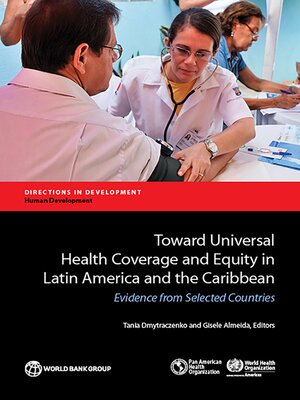Toward Universal Health Coverage and Equity in Latin America and the Caribbean
ebook ∣ Evidence from Selected Countries · Directions in Development--Human Development
By Tania Dmytraczenko

Sign up to save your library
With an OverDrive account, you can save your favorite libraries for at-a-glance information about availability. Find out more about OverDrive accounts.
Find this title in Libby, the library reading app by OverDrive.



Search for a digital library with this title
Title found at these libraries:
| Library Name | Distance |
|---|---|
| Loading... |
Over the past three decades, many countries in Latin America and the Caribbean have recognized health as a human right. Since the early 2000s, 46 million more people in the countries studied are covered by health programs with explicit entitlements to care. Reforms have been accompanied by a rise in public spending for health, financed largely by general revenues that prioritize or explicitly target the population without capacity to pay. Political commitment has generally translated into larger budgets as well as passage of legislation that ring-fenced funding for health. Most countries have prioritized cost-effective primary care and have adopted purchasing methods that incentivize efficiency and accountability for results and that give stewards of the health sector greater leverage to steer providers to deliver on public health priorities. Despite progress, disparities remain in financing and quality of services provision across health subsystems. Delivering on the commitment to universal health coverage will require concerted efforts to improve revenue generation in a fiscally sustainable manner and to increase the productivity of expenditures. In Toward Universal Health Coverage and Equity in Latin America and the Caribbean: Evidence from Select Countries, the authors show that evidence from an analysis of 54 household surveys corroborates that investments in extending coverage are yielding results. Although the poor still have worse health outcomes than do the rich, disparities have narrowed considerably — particularly in the early stages of life. Countries have reached high levels of coverage and equity in utilization of maternal and child health services. The picture is more nuanced, and not nearly as positive, regarding adult health status and prevalence of chronic conditions and illnesses. Coverage of noncommunicable disease interventions is not as high, and service utilization is still skewed toward those who are better off. Prevalence of noncommunicable diseases has not behaved as expected given the drop in mortality; better access to diagnosis among wealthier individuals may be masking changes in actual prevalence. Catastrophic health expenditures have declined in most countries. The picture regarding equity, however, is mixed, pointing to limitations in the measure. Although the rate of impoverishment owing to health expenditures is low and generally declining, 2–4 million people in the countries studied still fall below the poverty line after health spending. Efforts to systematically monitor quality of care in the region are still in their infancy. Nonetheless, a review of the literature reveals important shortcomings in quality of care, as well as substantial differences across subsystems. Improving quality of care and ensuring sustainability of investments in health remain an unfinished agenda.







